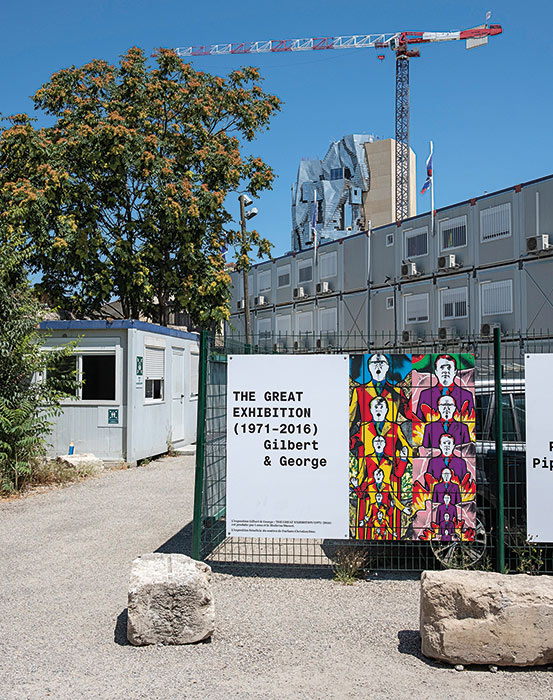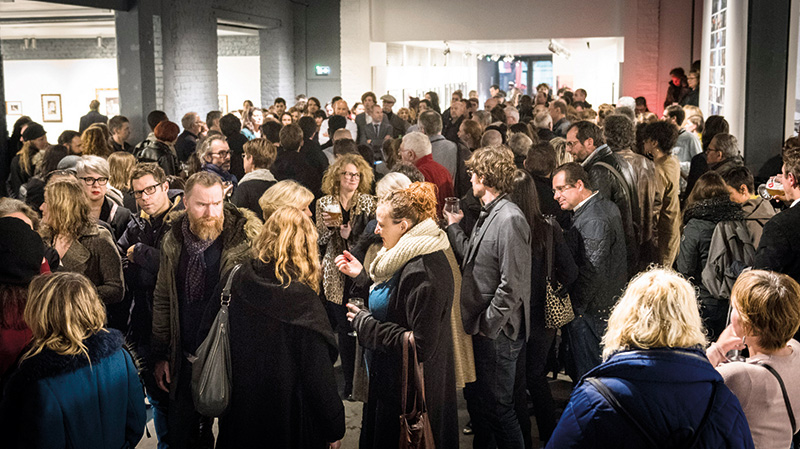[The Geopolitics of French Institutional Photographic Culture as of Summer 2018]
By Bruno Chalifour
A year from its fiftieth anniversary, Les Rencontres Internationales de la Photographie (the festival’s original name), now simply Rencontres de la Photographie, hosted its usual huge program, composed of more than fifty exhibitions in thirty-six sites, from July 2 to September 23. As usual, the climax of the festival, the opening week – this year from July 2 to July 7 – also offered a plethora of events (encounters and interviews, guided visits, exhibitions, and gatherings related to almost a dozen photographic awards, including several for photobooks, as well as photographic internships).
Maja Hoffman and the LUMA Foundation
Since the beginning of the millennium, the Arles festival would not have been what it is without the support of the LUMA Foundation and its president, Maja Hoffman (a long article was published on this subject “Maja’s Masterpiece,” Wall Street Journal Magazine, no. 96 [September 2018]: 194–99). While continuing her support for and tireless contribution to the festival, Hoffman now has personal momentum and is setting out to dominate cultural life in Arles. Her foundation purchased an enormous block of workshops from the French state-owned railway company, SNCF, while the public authorities were dragging their feet about signing on to a project that would have made the site a European centre for the image, bringing together the École Nationale Supérieure de la Photographie (maintained), the publisher Actes Sud (unresolved), the Institut Universitaire Technologique sur les métiers de l’image (existing), a new site for Les Rencontres de la Photographie (removed), and, above all, a planned centre for conservation of the French photographic patrimony, which has been housed in recent years, for better or worse (really, for worse rather than better), in limestone grottos in the Paris region since the creation of Jeu de Paume (previously the Centre National de la Photographie, of which Robert Delpire was the first director) and the eviction of the Patrimoine Photographique from its quarters in the private Parisian hotel on Rue de Rivoli near the Maison Européenne de la Photographie. Given the political inertia – no doubt also politically motivated since 2015, when the left-wing socio-communist majority was ousted wholesale from the Provence-Côte d’Azur regional council in favour of the Républicains (81 seats) and the Front National (42 seats) and the mayor of Arles since 2001 (and now in office until 2020), Hervé Schiavetti, was elected under the communist banner – Hoffman asked architect Frank Gehry to design a contemporary art centre. The building is topped by a sixty-metre-high tower, visible from five kilometres from the old town in the middle of which it is supposed to be integrated. At the same time, Hoffman took on the renovation of three of the SNCF workshop buildings, which she brought up to museum standards; presented there this year, among others, is an enormous retrospective by Gilbert & George (English photographers), whose anuses can be admired as a mural in an air-conditioned, humidity-controlled gallery.
Les Rencontres itself, touted as “breathtaking” and “celestial” by director Sam Stourzé, was organized this year around seven themes: “America Great Again!”; “Cours camarade, le vieux monde est derrière toi” (Run, friend, the old world is behind you), subtitled “1968, l’année qui a changé le monde” (1968: the year that changed the world); “Humanité aug- mentée” (Augmented humanity); “Le monde tel qu’il va” (The world as it is going); “Les plateformes du visible” (The platforms of the visible); “Figures de styles” (Figures of style); and “Dialogues.”
Problems on the horizon
The abundance and diversity of the Rencontres program should not paper over the serious problems that emerged this summer. Chief among them was the network of exhibition sites: new spaces had to be found to host the exhibitions that could no longer be presented at the SNCF workshops (including those that featured the ten competitors for the Prix Découverte). The temporary solutions devised took the festival back more than thirty years, into inappropriate spaces (often very warm and humid, such as the deserted first floor [under the roof] of the local Monoprix retail outlet, and into disused SNCF workshops) – manifesting, in short, a lack of respect for the artworks (security and conservation). Then, there was a major public funding shortfall that affected both Les Rencontres (for now moderately, but who knows) and the Voies Off festival, which has had its grants from the Conseil Régional PACA for the next year completely wiped out, putting into question its existence and the jobs of its few employees. This is not an isolated situation in France, as we shall see below.
The Plan for the Institut pour la Photographie des Hauts-de-France
In terms of the town of Arles and Les Rencontres, the plan for the Arles centre européen de l’image, with the creation of a site for Les Rencontres (finally meeting museum standards) and a home for the French photographic patrimony, seems to be quickly taking on water (especially with the radical change in political composition of the Conseil régional PACA, which is catastrophic for culture and, especially, for Arles). I thought I glimpsed Stourze’s frustration expressed indirectly during the press conference confirming the creation of the Institut pour la Photographie dans les Hauts-de-France in Lille (announced during the 2017 Rencontres). It already has a website: https://www. institut-photo.com. The current board is composed of Marin Karmitz (chair), Stourzé (future career change?), and Xavier Bertrand (president of the Hauts-de-France region). Bertrand took on the task of presenting an ambitious international-scale project, lodged in a former college in central Lille, with exhibition site, conference room, classrooms, and possible housing of the French photographic patrimony. The institute’s first conference, held October 17–19, was on the themes of photographic conservation and the photographic patrimony.
Who’s out to get La Maison de la Photographie de Lille?
This project sounds a clear knell for the Arles plan, a sad reality for Les Rencontres and, of course, for Arles and for its mayor, who had counted heavily and spent energy on the city’s cultural and economic future. It has also sounded the knell for La Maison de la Photo de Lille. The Institut pour la Photographie is Bertrand’s baby to a certain extent (he was in the Républicain party until he quit in 2017 due to Laurent Wauquiez’s turn to the extreme right); he was elected president of the region thanks to a right–left coalition created to stand against Marine Le Pen (who led the first round of voting with 40 percent). This little political detour helps to explain the total silence of the ex-minister and current mayor of Lille, socialist Martine Aubry – who also attended Arles – when I asked her to justify the withdrawal of the annual grant (€130,000 planned for 2018, down from €200,000 in the early 2000s) to La Maison de la Photo – a grant that her municipality had up to then allocated to its parent association, founded in 1997, L’atelier de la Photo.
Installed in a working-class neighbourhood on the edge of Lille (8 Rue Frémy, in Fives), L’atelier de la Photo had established La Maison de la Photo as an exhibition venue in 2003. Its mission included education and exhibitions (George Rousse, William Klein, Frank Horvat, Willy Ronis, Tendance Floue, Helmut Newton, and others), an annual national festival, Les Transphotographiques, and a collaboration with La Maison Européenne de la photographie and its director, Jean-Luc Monterosso. In April, the municipality allocated part of its grant, €30,000, to Les Trans-photographiques alone, but at the same time it refused the festival access to a site that it usually occupied, Le Tri Postal.
In a press release dated October 18, the director of La Maison de la Photographie, Olivier Spillebout, deplored the lack of cooperation and transparency that had seemed to have characterized the project over the previous year. He expressed surprise at the large disparity created with Les Rencontres d’Arles, as many other national structures were not invited to the working table, and at the fact that the exhibition space in such an expensive project would be barely superior to that at La Maison de la Photographie. He noted that Lille, with La Maison de la Photographie, already had a structure, a space, and educational and exhibition activities that would no doubt be less costly to improve, and that other cities in the region, some of which already had a past linked to photography, could benefit from playing host to the Institut. Finally, he asked what would become of continuing education and local artists in the new Institut.
For the moment, it seems that La Maison de la Photographie, like Voies Off in Arles, will have to review the conditions for its existence while watching the new Institut pour la Photographie rising from its ashes. A few clouds are thus on the horizon, including possibly the end of associative structures in the field in favour of institutionalized groups. It seems that the principles of the market economy are prevailing over cooperation and participation, and that power, even embodied in democratically elected politicians, is not easy to share in a French blue sky that is affirmed as more and more photographic, even in France’s own Pays Plat.
Translated by Käthe Roth
Bruno Chalifour is a photographer who has been teaching and writing about photography for more than forty years. He moved to the United States in 1994 and was editor-in-chief of the magazine Afterimage, published by the Visual Studies Workshop, in Rochester, New York (2002–05) and director of Spectrum Gallery, in Rochester (2014–15). His essays have been published in France, Australia, Canada, the United Kingdom, and the United States, and his images have been in numerous solo and group exhibitions in France and the United States.
[ Complete issue, in print and digital version, available here: Ciel variable 111 – THE SPACE OF COLOUR ]
[ Individual article in digital version available here: Les Rencontres d’Arles. Warm and Sunny with Possibility of Showers! — Bruno Chalifour ]





